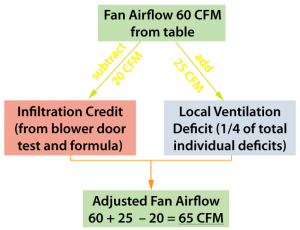 The American Society of Heating Refrigeration and Air-Conditioning Engineers (ASHRAE) published its current ventilation standard, 62.2-2010 in 2010. The standard has been controversial when applied to existing homes, especially in the Department of Energy’s Weatherization Assistance Program (WAP). WAP practitioners question the cost and the benefits of moving from the legacy ventilation standard (ASHRAE 62-1989) to the far more complex new one (ASHRAE 62.2-2010), with its prodigious training requirements.
The American Society of Heating Refrigeration and Air-Conditioning Engineers (ASHRAE) published its current ventilation standard, 62.2-2010 in 2010. The standard has been controversial when applied to existing homes, especially in the Department of Energy’s Weatherization Assistance Program (WAP). WAP practitioners question the cost and the benefits of moving from the legacy ventilation standard (ASHRAE 62-1989) to the far more complex new one (ASHRAE 62.2-2010), with its prodigious training requirements.
All homes need a fan-powered ventilation system according to ASHRAE 62.2, except for extremely leaky homes. Despite the steady drumbeat for compliance from ASHRAE members the 2012 International Residential Code (IRC) and the International Energy Conservation Code (IECC) don’t reference the standard. The IRC and IECC opt for simpler approaches than ASHRAE 62.2, which is difficult to understand.
ASHRAE 62.2 standard
The standard specifies the whole-building ventilation fan’s required airflow according to either a formula or a table. The formula is:
0.02 X floor area + 7.5 times bedrooms or occupants = required airflow in CFM
Using the formula tends to give you the minimum required fan airflow compared to the ASHRAE 62.2 table, which gives slightly higher values.
From the required airflow for the whole-building ventilation fan you can calculate an “infiltration credit”, which reduces the required airflow if the home’s measured infiltration rate is more than the standard’s assumed infiltration rate of 2 CFM per 100 square feet of home floor space. You get to take half of the excess infiltration as a credit which reduces the whole-building ventilation fan’s required airflow.
ASHRAE 62.2 also allows you to make up for a deficit in local ventilation capacity. ASHRAE 62.2 requires 100 CFM for kitchens and 50 CFM for bathrooms. You can add one-quarter of the total local ventilation deficit to the whole-building ventilation fan’s airflow requirement to make up for this “local ventilation deficit.”
The diagram show here is from our technical reference sheet on ASHRAE 62.2 and gives a graphic representation of the process.
Why it is a Problem
This ASHRAE 62.2 procedure is more complex than it needs to be considering the precision that it is likely to be applied on the job. ASHRAE should go back to committee and give us a simpler standard that doesn’t require the huge training commitment with which the current standard burdens our industry.


National WAP IAQ study conclusions state:”Few homes in sample suffer from serious indoor air quality problems pre-weatherization”. Couple this with average measured energy savings of $240/home. Should DOE consider the results of the National WAP Evaluation when creating program requirements?